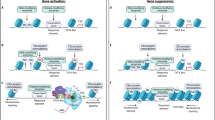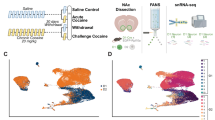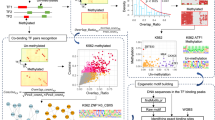Abstract
The behavioral sensitization produced by repeated cocaine treatment represents the neural adaptations underlying some of the features of addiction in humans. Cocaine administrations induce neural adaptations through regulation of gene expression. Several studies suggest that epigenetic modifications, including DNA methylation, are the critical regulators of gene expression in the adult central nervous system. DNA methylation is catalyzed by DNA methyltransferases (DNMTs) and consequent promoter region hypermethylation is associated with transcriptional silencing. In this study a potential role for DNA methylation in a cocaine-induced behavioral sensitization model in mice was explored. We report that acute cocaine treatment caused an upregulation of DNMT3A and DNMT3B gene expression in the nucleus accumbens (NAc). Using methylated DNA immunoprecipitation, DNA bisulfite modification, and chromatin immunoprecipitation assays, we observed that cocaine treatment resulted in DNA hypermethylation and increased binding of methyl CpG binding protein 2 (MeCP2) at the protein phosphatase-1 catalytic subunit (PP1c) promoter. These changes are associated with transcriptional downregulation of PP1c in NAc. In contrast, acute and repeated cocaine administrations induced hypomethylation and decreased binding of MeCP2 at the fosB promoter, and these are associated with transcriptional upregulation of fosB in NAc. We also found that pharmacological inhibition of DNMT by zebularine treatment decreased cocaine-induced DNA hypermethylation at the PP1c promoter and attenuated PP1c mRNA downregulation in NAc. Finally, zebularine and cocaine co-treatment delayed the development of cocaine-induced behavioral sensitization. Together, these results suggest that dynamic changes of DNA methylation may be an important gene regulation mechanism underlying cocaine-induced behavioral sensitization.
Similar content being viewed by others
Log in or create a free account to read this content
Gain free access to this article, as well as selected content from this journal and more on nature.com
or
References
Amir RE, Van den Veyver IB, Wan M, Tran CQ, Francke U, Zoghbi HY (1999). Rett syndrome is caused by mutations in X-linked MECP2, encoding methyl-CpG-binding protein 2. Nat Genet 23: 185–188.
Berke JD, Hyman SE (2000). Addiction, dopamine, and the molecular mechanisms of memory. Neuron 25: 515–532.
Bestor TH (2000). The DNA methyltransferases of mammals. Hum Mol Genet 9: 2395–2402.
Bird A (2002). DNA methylation patterns and epigenetic memory. Genes Dev 16: 6–21.
Brami-Cherrier K, Roze E, Girault JA, Betuing S, Caboche J (2009). Role of the ERK/MSK1 signalling pathway in chromatin remodelling and brain responses to drugs of abuse. J Neurochem 108: 1323–1335.
Brami-Cherrier K, Valjent E, Hervé D, Darragh J, Corvol JC, Pages C et al (2005). Parsing molecular and behavioral effects of cocaine in mitogen- and stress-activated protein kinase-1-deficient mice. J Neurosci 25: 11444–11454.
Brooks PJ, Marietta C, Goldman D (1996). DNA mismatch repair and DNA methylation in adult brain neurons. J Neurosci 16: 939–945.
Canettieri G, Morantte I, Guzman E, Asahara H, Herzig S, Anderson SD et al (2003). Attenuation of a phosphorylation-dependent activator by an HDAC-PP1 complex. Nat Struct Biol 10: 175–181.
Diaz-Flores E, Shannon K (2007). Targeting oncogenic Ras. Gene Dev 21: 1989–1992.
Fasano S, Brambilla R (2002). Cellular mechanisms of striatum-dependent behavioral plasticity and drug addiction. Curr Mol Med 2: 649–665.
Genoux D, Haditsch U, Knobloch M, Michalon A, Storm D, Mansuy IM (2002). Protein phosphatase 1 is a molecular constraint on learning and memory. Nature 418: 970–975.
Girault JA, Valjent E, Caboche J, Herve D (2007). ERK2: a logical and gate critical for drug-induced plasticity? Curr Opin Pharmacol 7: 77–85.
Endres M, Fan G, Meisel A, Dirnagl U, Jaenisch R (2001). Effects of cerebral ischemia in mice lacking DNA methyltransferase 1 in post-mitotic neurons. NeuroReport 12: 3763–3766.
Endres M, Meisel A, Biniszkiewicz D, Namura S, Prass K, Ruscher K et al (2000). DNA methyltransferase contributes to delayed ischemic brain injury. J Neurosci 20: 3175–3181.
Fan G, Beard C, Chen RZ, Csankovszki G, Sun Y, Siniaia M et al (2001). DNA hypomethylation perturbs the function and survival of CNS neurons in postnatal animals. J Neurosci 21: 788–797.
Goll MG, Bestor TH (2005). Eukaryotic cytosine methyltransferases. Annu Rev Biochem 74: 481–514.
Holleran JL, Parise RA, Joseph E, Eiseman JL, Covey JM, Glaze ER et al (2005). Plasma pharmacokinetics, oral bioavailability, and interspecies scaling of the DNA methyltransferase inhibitor, zebularine. Clin Cancer Res 11: 3862–3868.
Hope BT, Nye HE, Kelz MB, Self DW, Iadarola MJ, Nakabeppu Y et al (1994). Induction of a long-lasting AP-1 complex composed of altered Fos-like proteins in brain by chronic cocaine and other chronic treatments. Neuron 13: 1235–1244.
Jones PA, Baylin SB (2002). The fundamental role of epigenetic events in cancer. Nat Rev Genet 3: 415–428.
Kangaspeska S, Stride B, Metivier R, Polycarpou-Schwarz M, Ibberson D, Carmouche RP et al (2008). Transient cyclical methylation of promoter DNA. Nature 452: 112–115.
Koob GF, Bloom FE (1988). Cellular and molecular mechanisms of drug dependence. Science 242: 715–723.
Kouzarides T (2007). Chromatin modifications and their function. Cell 128: 693–705.
Kumar A, Choi KH, Renthal W, Tsankova NM, Theobald DE, Truong HT et al (2005). Chromatin remodeling is a key mechanism underlying cocaine-induced plasticity in striatum. Neuron 48: 303–314.
Levine AA, Guan Z, Barco A, Xu S, Kandel ER, Schwartz JH (2005). CREB-binding protein controls response to cocaine by acetylating histones at the fosB promoter in the mouse striatum. Proc Natl Acad Sci USA 102: 19186–19191.
Li B, Carey M, Workman JL (2007). The role of chromatin during transcription. Cell 128: 707–719.
Livak KJ, Schmittgen TD (2001). Analysis of relative gene expression data using real-time quantitative PCR and the 2(-Delta Delta C(T)) method. Methods 25: 402–408.
Lu R, Wang X, Chen Z-F, Sun D-F, Tian X-Q, Fang J-Y (2007). Inhibition of extracellular signal regulated kinase mitogen-activated protein kinase pathway decrease DNA-methylation in colon cancer cells. J Biol Chem 282: 12249–12259.
Lubin FD, Roth TL, Sweatt JD (2008). Epigenetic regulation of BDNF gene transcription in the consolidation of fear memory. J Neurosci 28: 10576–10586.
MacLeod AR, Rouleau J, Szyf M (1995). Regulation of DNA methylation by the Ras signaling pathway. J Biol Chem 270: 11327–11337.
Ma DK, Guo JU, Ming GL, Song H (2009). DNA excision repair proteins and Gadd45 as molecular players for active DNA demethylation. Cell Cycle 8: 1526–1531.
Marquez VE, Kelley JA, Agbaria R, Ben-Kasus T, Cheng JC, Yoo CB et al (2005). Zebularine: a unique molecule for an epigenetically based strategy in cancer chemotherapy. Ann NY Acad Sci 1058: 246–254.
Métivier R, Huet G, Gallais R, Finot L, Petit F, Tiffoche C et al (2008). Dynamics of estrogen receptor-mediated transcriptional activation of responsive genes in vivo: apprehending transcription in four dimensions. Adv Exp Med Biol 617: 129–138.
Miller CA, Sweatt JD (2007). Covalent modification of DNA regulates memory formation. Neuron 53: 857–869.
Morgan MA, Ganser A, Reuter CW (2007). Targeting the RAS signaling pathway in malignant hematologic diseases. Curr Drug Target 8: 217–235.
Nestler EJ, Aghajanian GK (1997). Molecular and cellular basis of addiction. Science 278: 58–63.
Nestler EJ (2001). Molecular basis of long-term plasticity underlying addiction. Nat Rev Neurosci 2: 119–128.
Ooi SK, Bestor TH (2008). The colorful history of active DNA demethylation. Cell 133: 1145–1148.
Patra SK, Szyf M (2008). DNA methylation-mediated nucleosome dynamics and oncogenic Ras signaling. Insights from FAS, FAS ligand and RASSF1A. FEBS J 275: 5217–5235.
Paxinos G, Franklin KBJ (2001). The Mouse Brain in Stereotaxic Coordinates. Academic Press: San Diego, CA.
Philips MR (2004). Methotrexate and Ras methylation: a new trick for an old drug? Sci STKE 225: pe13.
Pierce RC, Kalivas PW (1997). A circuitry model of the expression of behavioral sensitization to amphetamine-like psychostimulants. Brain Res Rev 25: 192–216.
Renthal W, Carle TL, Maze I, Covington III HE, Truong HT, Alibhai I et al (2008). Delta FosB mediates epigenetic desensitization of the c-fos gene after chronic amphetamine exposure. J Neurosci 28: 7344–7349.
Renthal W, Kumar A, Xiao G, Wilkinson M, Covington III HE, Maze I et al (2009). Genome-wide analysis of chromatin regulation by cocaine reveals a role for sirtuins. Neuron 62: 335–348.
Renthal W, Maze I, Krishnan V, Covington III HE, Xiao G, Kumar A et al (2007). Histone deacetylase 5 epigenetically controls behavioral adaptations to chronic emotional stimuli. Neuron 56: 517–529.
Renthal W, Nestler EJ (2008). Epigenetic mechanisms in drug addiction. Trends Mol Med 14: 341–350.
Robertson KD, Wolffe AP (2000). DNA methylation in health and disease. Nat Rev Genet 1: 11–19.
Robinson TE, Berridge KC (1993). The neural basis of drug craving: an incentive-sensitization theory of addiction. Brain Res Rev 18: 247–291.
Shahbazian MD, Grunstein M (2007). Functions of site-specific histone acetylation and deacetylation. Annu Rev Biochem 76: 75–100.
Shen HY, Kalda A, Yu L, Ferrara J, Zhu J, Chen JF (2008). Additive effects of histone deacetylase inhibitors and amphetamine on histone H4 acetylation, cAMP responsive element binding protein phosphorylation and DeltaFosB expression in the striatum and locomotor sensitization in mice. Neuroscience 157: 644–655.
Siedlecki P, Zielenkiewicz P (2006). Mammalian DNA methyltransferases. Acta Biochim Pol 53: 245–256.
Singal R, Ginder GD (1999). DNA methylation. Blood 93: 4059–4070.
Stipanovich A, Valjent E, Matamales M, Nishi A, Ahn JH, Maroteaux M et al (2008). A phosphatase cascade by which rewarding stimuli control nucleosomal response. Nature 453: 879–884.
Sutcliffe JS, Nelson DL, Zhang F, Pieretti M, Caskey CT, Saxe D et al (1992). DNA methylation represses FMR-1 transcription in fragile X syndrome. Hum Mol Genet 1: 397–400.
Swank MW, Sweatt JD (2001). Increased histone acetyltransferase and lysine acetyltransferase activity and biphasic activation of the ERK/RSK cascade in insular cortex during novel taste learning. J Neurosci 21: 3383–3391.
Veldic M, Caruncho HJ, Liu WS, Davis J, Satta R, Grayson DR et al (2004). DNA-methyltransferase 1 mRNA is selectively overexpressed in telencephalic GABAergic interneurons of schizophrenia brains. Proc Natl Acad Sci USA 101: 348–353.
Weisenberger DJ, Velicescu M, Cheng JC, Gonzales FA, Liang G, Jones PA (2004). Role of the DNA methyltransferase variant DNMT3b3 in DNA methylation. Mol Cancer Res 2: 62–72.
Acknowledgements
We thank Dr G Tasa for help with methylation-specific real-time PCR and MeDIP analysis and A Harrison for critical reading of the paper. This study was supported by the Estonian Science Foundation (Grant ETF7585), University of Tartu (Grant PARFR08903), and European Regional Development Fund.
Author information
Authors and Affiliations
Corresponding author
Ethics declarations
Competing interests
The authors declare no conflict of interest.
Additional information
Supplementary Information accompanies the paper on the Neuropsychopharmacology website
Rights and permissions
About this article
Cite this article
Anier, K., Malinovskaja, K., Aonurm-Helm, A. et al. DNA Methylation Regulates Cocaine-Induced Behavioral Sensitization in Mice. Neuropsychopharmacol 35, 2450–2461 (2010). https://doi.org/10.1038/npp.2010.128
Received:
Revised:
Accepted:
Published:
Issue date:
DOI: https://doi.org/10.1038/npp.2010.128
Keywords
This article is cited by
-
Psychostimulant-induced aberrant DNA methylation in an in vitro model of human peripheral blood mononuclear cells
Clinical Epigenetics (2022)
-
Key transcription factors mediating cocaine-induced plasticity in the nucleus accumbens
Molecular Psychiatry (2022)
-
Regulation of dopamine-dependent transcription and cocaine action by Gadd45b
Neuropsychopharmacology (2021)
-
Effects of the monoamine stabilizer, (-)-OSU6162, on cocaine-induced locomotion and conditioned place preference in mice
Naunyn-Schmiedeberg's Archives of Pharmacology (2021)
-
Methionine Supplementation Abolishes Nicotine-Induced Place Preference in Zebrafish: a Behavioral and Molecular Analysis
Molecular Neurobiology (2021)



